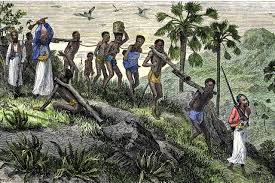Introduction
The slave trade remains one of the darkest chapters in African history. For over four centuries, millions of Africans were captured, sold, and transported across the Atlantic Ocean under brutal conditions. The trade not only depopulated the continent but also left lasting scars on African societies, economies, and cultures.
In this post, we’ll explore the causes of the slave trade, Major Regions Where it occurs, Nigeria as a Case Study and the Abolition.
Causes of the Slave Trade in Africa
Several factors contributed to the emergence and growth of the slave trade:
- Demand for Labor:
European colonies in the Americas needed a steady supply of cheap labor for plantations growing sugar, cotton, and tobacco. Africans were viewed as a strong labor force suited for the harsh conditions. - Economic Incentives:
African rulers, merchants, and middlemen found the trade profitable. They exchanged slaves for guns, alcohol, textiles, and other goods from European traders. - Internal Conflicts:
Frequent wars and tribal conflicts created prisoners of war, who were often sold into slavery. This became a means of gaining wealth and power for local leaders. - European Expansion:
The rise of European maritime powers and their search for wealth encouraged the establishment of coastal trading posts, which facilitated large-scale slave exports.
Major Regions Where the Slave Trade Occurred
The slave trade touched nearly every region of Africa, but some areas became notorious hubs:
- West Africa: Modern day Nigeria, Ghana, Senegal, and Sierra Leone were central to the transatlantic trade.
- Central Africa: Regions like the Congo and Angola supplied vast numbers of enslaved people.
- East Africa: Ports like Zanzibar and Mombasa played a role in the Indian Ocean slave trade, sending captives to the Middle East and Asia.
Nigeria as a Case Study
Nigeria was one of the most active centers of the slave trade in West Africa due to its coastal position and the presence of powerful kingdoms.
- Major Slave Ports
- Badagry (Lagos State): One of the most significant slave ports, where captured Africans were kept in “slave barracoons” before being shipped across the Atlantic.
- Bonny and Calabar: Located in the Niger Delta, these towns were central points in the export of slaves, often controlled by local chiefs who traded captives for European goods.
- Brass and Opobo: These ports thrived during the late slave trade period, driven by powerful Niger Delta merchant families.
- Local Involvement
Some local rulers and merchants participated in the trade, capturing people from rival communities or inland regions and selling them to European traders. Over time, this practice deeply destabilized many Nigerian societies, leading to mistrust, conflict, and depopulation.
The Abolition of the Slave Trade
The abolition of the slave trade was a gradual and complex process influenced by several factors:
- Humanitarian Movements:
European abolitionists like William Wilberforce and African leaders such as Olaudah Equiano (a freed Nigerian slave) campaigned vigorously against the trade’s brutality. - Economic Shifts:
The Industrial Revolution made wage labor more profitable than slavery. Factories needed free consumers, not enslaved laborers. - Legislation:
- 1807: Britain passed the Abolition of the Slave Trade Act, making the trade illegal for British subjects.
- 1833: The Slavery Abolition Act freed slaves across the British Empire, including in its West African colonies.
- In Nigeria, the British established coastal control and gradually suppressed the slave trade through treaties and military actions.
Legacy and Impact
The effects of the slave trade remain visible in Nigeria and across Africa today. It caused:
- Loss of population and skilled labor.
- Disruption of traditional societies and economies.
- Cultural fragmentation and mistrust among ethnic groups.
However, the abolition also opened paths for new forms of education, trade, and social reform, setting the stage for the later fight against colonialism.
- Religious Influence:
Christian missionaries spread messages of equality and freedom, contributing to changing moral attitudes about slavery.
Conclusion
The slave trade in Africa, particularly in Nigeria, reshaped the continent’s history forever. From the bustling ports of Badagry and Calabar to the struggle for abolition led by courageous individuals, this era teaches profound lessons about humanity, greed, and resilience. Remembering this history helps ensure such injustices never repeat themselves and that the stories of those who suffered are never forgotten.

